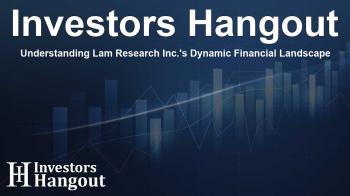Understanding Lam Research Inc.'s Dynamic Financial Landscape

Current Market Overview of Lam Research
In today's market, Lam Research Inc. (LRCX) has seen its share price settle at $98.05, exhibiting a slight decrease of 0.77%. Despite a notable increase of 7.85% over the past month, yearly performance tells a different story with a drop of 11.79%. Such metrics may cause long-term investors to assess the company's price-to-earnings (P/E) ratio to gauge its future value.
The Significance of the P/E Ratio
The P/E ratio serves as an essential tool for investors evaluating a company's profit relative to its current market value. It effectively compares the current share price to the earnings per share (EPS). A higher P/E ratio may suggest that investors foresee robust future growth and are thus willing to pay a premium for the stock. However, this could also imply an overvaluation.
How Lam Research Stands Against Its Peers
Notably, Lam Research's P/E ratio is lower than the industry average of 72.66, categorized within the Semiconductors & Semiconductor Equipment sector. This disparity might lead some investors to speculate that the stock is undervalued, presenting a potential opportunity.
Assessing the Growth Potential
Understanding the P/E ratio's implications is crucial, but investors should take caution. A lower P/E might indicate expectations of limited future growth among shareholders, signaling a need to assess other financial indicators and trends to build a comprehensive investment strategy.
Limitations of Relying Solely on the P/E Ratio
While the P/E ratio provides insights into market sentiment regarding a company's valuation, it shouldn’t be the singular metric driving investment decisions. Broader economic factors, industry trends, and competitive positioning must also be considered to get a holistic view of the investment landscape.
Conclusion: A Balanced Investment Perspective
In conclusion, Lam Research's current P/E ratio highlights uncertainties in long-term growth, even as short-term trends appear promising. Investors should combine this metric with other quantitative and qualitative analyses to make informed decisions. Keeping an open mind and regularly reviewing performance will be crucial as market dynamics continue to evolve.
Frequently Asked Questions
What is the current P/E ratio for Lam Research?
The current P/E ratio for Lam Research is lower than the industry average of 72.66, suggesting potential undervaluation.
How does Lam Research's share price compare to last month?
Lam Research's share price increased by 7.85% over the past month, indicating short-term positive momentum.
Why is the P/E ratio important for investors?
The P/E ratio helps investors assess how the market values a company's earnings in relation to its share price, aiding investment decisions.
What should investors consider beyond the P/E ratio?
Investors should also evaluate industry trends, economic conditions, and the company's competitive positioning to gain a fuller picture of potential investment risks and rewards.
Can a low P/E ratio mean a company is undervalued?
Yes, a low P/E ratio may indicate that a stock is undervalued, but it could also signal limited growth expectations, warranting cautious assessment.
About The Author
Contact Dylan Bailey privately here. Or send an email with ATTN: Dylan Bailey as the subject to contact@investorshangout.com.
About Investors Hangout
Investors Hangout is a leading online stock forum for financial discussion and learning, offering a wide range of free tools and resources. It draws in traders of all levels, who exchange market knowledge, investigate trading tactics, and keep an eye on industry developments in real time. Featuring financial articles, stock message boards, quotes, charts, company profiles, and live news updates. Through cooperative learning and a wealth of informational resources, it helps users from novices creating their first portfolios to experts honing their techniques. Join Investors Hangout today: https://investorshangout.com/
The content of this article is based on factual, publicly available information and does not represent legal, financial, or investment advice. Investors Hangout does not offer financial advice, and the author is not a licensed financial advisor. Consult a qualified advisor before making any financial or investment decisions based on this article. This article should not be considered advice to purchase, sell, or hold any securities or other investments. If any of the material provided here is inaccurate, please contact us for corrections.

